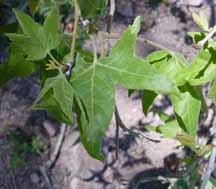
Arizona Sycamore (Platanus wrightii)
Main sources: Petrides, George & Olivia Petrides, 1992, A Field Guide to Western Trees, pp. 165-6, Houghton-Mifflin; Zimmerman, Robert, 1969, Plant Ecology of an Arid Basin Tres Alamos-Redington Area Southeastern Arizona, Geological Survey Professional Paper 485-D, Washington, D.C.; see also the USDA Forest Service Database.
These are large floodplain and lowland trees "with distinctive light green, whitish, or mottled bark that flakes off in irregular puzzlelike pieces, exposing yellowish and whitish underbark" (Petrides p. 165). Our Arizona species (or variety?) is the tallest tree of our lands (reaching some 80 feet high), has bark that looks very whitish at a distance (see banner photo, above), and its leaves tend to hang on it long after they have dried to a golden brown (the banner photo was taken in November of 2002)

The lower trunk of very large old trees is dark in color with loose-flaking plates, while younger branches on whitish and smooth. The tree to the left is just leafing out in April.
Sycamores form widespread, strongly branched root systems. They grow rapidly, tend to be long-lived (to 250 years), and some eastern varieties have attained heights of more than 150 feet. In Hot Springs Canyon they are few in number, but perhaps our most expansively shading, spectacular trees:
Below: young leaves, April 2003
Below: a mature leaf, November 2002
Sycamore leaves are quite large -- 4-10 inches long, nearly hairless, toothless, with 5 to 7 deep lobes (see the photos at left). Leafstalk bases are hollow, with sinuses extending more than halfway to the leaf bases. (Click on the images at left to enlarge them.)
Sycamores are not common in our portion of the San Pedro River drainage -- Zimmerman 1969 shows them only in Hot Springs, Paige, and (a small portion of) Redfield Canyons. We are concerned that they may be in decline in Hot Springs Canyon, since we are not seeing many young trees and some of the old ones have died.
For more detailed images, click here.
Return to Trees & Shrubs


